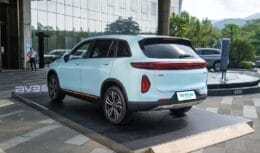
Even with regenerative brakes serving to give more autonomy to electric cars, it is important to understand how everything actually works, to maintain the safety of both the vehicle and the driver.
Regenerative brakes, in addition to reducing speed and stopping the vehicle, also have the function of recovering part of the battery charge of electric and hybrid cars. Even though it is present in more modern car models, this technology has a very simple concept.
Related articles
- Chinese BYD opens new electric car dealership in Porto Alegre (RS)
- Electric cars to supply homes, this is GM's proposal with its new bidirectional charging system
- The rise in the price of nickel, as a result of the war, could cause a disruption in the production of electric car batteries
- Head of Korean automaker Hyundai Motor reveals ambitious plan to sell 1,897 million electric cars and manufacture more efficient batteries to secure 7% of the global market; dispute with the giants GM, Ford and Tesla will intensify!
- Nuclear cars: 8.000 kilometers of autonomy and other impossible dreams
Understand how regenerative brakes work
The electric motor, which is responsible for pulling the vehicle, can also function as a type of electricity generator, a kind of alternator to supply energy directly to the batteries, as a way of increasing the vehicle's autonomy.
In this way, the electric motor starts to supply energy to the batteries every time the driver applies the brakes or just eases the acceleration. During braking, a sensor sends signals to an electronic module that converts the propeller into a generator, taking advantage of all the movement of the car's wheels, the so-called kinetic energy, generating energy that is then sent to the batteries.
Depending on the electric car and its power, the capacity of the regenerative brakes can be strong enough to stop the vehicle without having to apply the conventional wheel brakes.
The importance of regenerative braking
In a brief example, it can be said that, if by chance the driver needs to go down a mountain, the energy regeneration system can work as a very efficient “engine brake”, serving to reduce the speed of the car, in addition to generating electricity to recharge the batteries.
One more example of the importance and efficiency of regenerative brakes is the Porsche Taycan sports model, where conventional brakes only need to be actually activated to help the electric motors in moments of stronger braking.
According to data from Porsche, the energy regeneration system is responsible for acting in about 90% of the car's braking and is also capable of adding another 4 km to the autonomy of the batteries, when braking at 200 km/h until the car comes to a complete stop. Regenerative brakes also contribute to increasing the useful life of friction components, such as discs, pads, drums and linings, in addition to preserving wheel brakes.
Essential Care
It is important to point out that if the car is fully charged, that is, 100% charged, the regenerative brakes may not function as energy generators, but this situation is more common in hybrid models, as the combustion engine also works as a generator.
This happens because the battery, like a fuel tank, does not have the capacity to store electricity beyond its own limit. Therefore, it is important to warn that any attempt to recharge in conditions like these could overheat the engine, running the risk of exploding the energy accumulator. This limitation is also connected to the fact that quick recharges at charging stations do not exceed 80% of capacity, for safety reasons.












Air Force F-16 fighters…
True friend, what they shot down were…
Air Force F-16 fighters…
Well... It's flying scrap... Typical...
Air Force F-16 fighters…
I would like to know what planet you live on…
They discover the third largest deposit…
That’s why all foreigners and NGOs…
Air Force F-16 fighters…
Which genocide are you talking about? Than…
Just for writing lol
You want a racing car, buy one…
Saying that a 113 HP engine…
Yes, I’ve had 4 Monzas of the year…
Yes, I intend to have a Yaris Cross,
Forests are essential to stabilize global warming…
The search for alternatives to obtain…
These nobio batteries like 6 minutes…